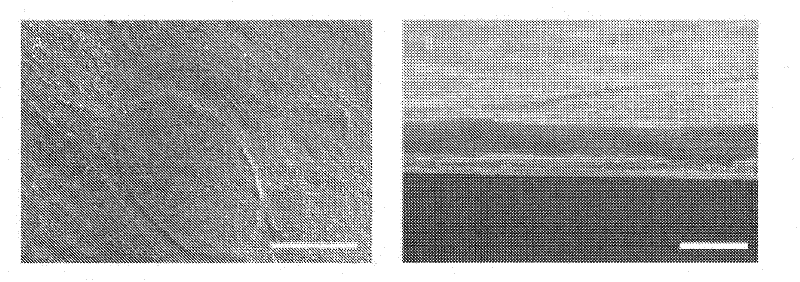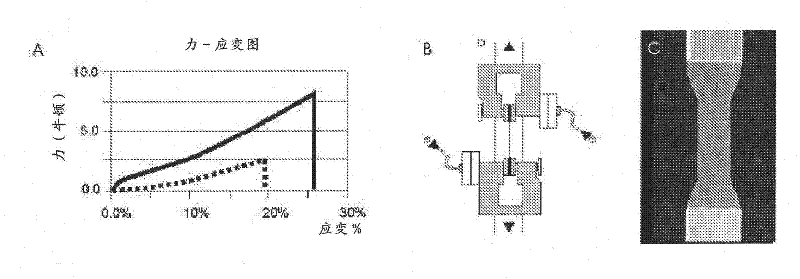Method for the cryopreservation of cells, artificial cell constructs or three-dimensional complex tissues assemblies
A three-dimensional composite and artificial cell technology, which is applied in the preservation of human or animal bodies, tissue culture, animal cells, etc., can solve the problems of lack of mechanical stability and negative impact on cell vitality, and achieve the effect of improving survival rate and vitality
- Summary
- Abstract
- Description
- Claims
- Application Information
AI Technical Summary
Problems solved by technology
Method used
Image
Examples
Embodiment 1
[0165] Example 1. Preparation of collagen cell carrier
[0166] 1.1 Production of planar film of the present invention
[0167] 50.0 kg of bovine hide splits were mechanically pre-cut and washed three times with water (3×50 kg). Subsequently, the raw material was placed in 50 kg of aqueous suspension (pH value of 11.8) of 0.29 kg of calcium hydroxide for alkali treatment for 150 hours. The alkaline treatment was terminated by adding hydrochloric acid (10% by weight in water) until the pH of the suspension reached 0.6. The reaction mixture was then rinsed again with water until the suspension reached pH 2.8. The resulting "collagen shell" is then mechanically processed under temperature control (<24°C) into a gelatinous viscoelastic mass by coarse grinding and pressing the broken material through a series of perforated discs with successively decreasing pore sizes. accomplish. The yield was 78.1 kg of "concentrated" collagen mass.
[0168] 60.0 kg of said "concentrated" ma...
Embodiment 2
[0184] Example 2: Cryopreservation of adherent primary cardiomyocytes
[0185] Successful cryopreservation of cultured stem cells and / or primary cardiac cells such as cardiomyocytes is a prerequisite for future cell-based therapies in the field of cardiovascular diseases.
[0186] Cryopreservation of adherently cultured primary cardiomyocytes on biocompatible scaffolds offers several advantages in terms of cell survival, cell organization, and cell biological function compared to freezing single-cell suspensions.
[0187] To assess cryopreservation of adherent primary cardiomyocytes, cardiac cells were isolated from fetal mice (E15) and cultured according to Example 1 (see Figure 5 ) prepared on the collagen cell carrier. Subsequently, the cell-seeded scaffolds were frozen in liquid nitrogen for 3 weeks and analyzed after thawing.
[0188] Fetal mouse hearts were prepared and collected in Hanks' balanced buffered salt solution (PAA, Pasching, Austria). Ventricles were isol...
Embodiment 3
[0192] Example 3: Long-term cryopreservation of adherent SAOS-2 cells
[0193] To analyze the long-term cryopreservation of adherent cells, the osteosarcoma cell line SAOS-2 was cultured on the collagen cell carrier prepared according to Example 1 and stored in liquid nitrogen for 230 days. After thawing, adherent cells were analyzed by cell proliferation assay.
[0194] Seed the SAOS-2 cells on the collagen cell carrier described in Example 1 at a density of 25,000 cells per square centimeter, in a humid incubator at 37°C and 5% CO 2 conditions for 3 days. The medium consisted of HEPES-buffered DMEM medium (PAA) supplemented with penicillin / streptomycin and 10% (v / v) FCS. For cryopreservation, these cell-seeded scaffolds were transferred to cryovials and the culture medium was replaced with freezing medium (DMEM medium buffered with HEPES supplemented with penicillin / streptomycin, 20% (v / v ) FCS and 10% (v / v) DMSO (Sigma)). The cryovials containing the collagen cell carri...
PUM
| Property | Measurement | Unit |
|---|---|---|
| thickness | aaaaa | aaaaa |
| thickness | aaaaa | aaaaa |
| thickness | aaaaa | aaaaa |
Abstract
Description
Claims
Application Information
 Login to View More
Login to View More - R&D
- Intellectual Property
- Life Sciences
- Materials
- Tech Scout
- Unparalleled Data Quality
- Higher Quality Content
- 60% Fewer Hallucinations
Browse by: Latest US Patents, China's latest patents, Technical Efficacy Thesaurus, Application Domain, Technology Topic, Popular Technical Reports.
© 2025 PatSnap. All rights reserved.Legal|Privacy policy|Modern Slavery Act Transparency Statement|Sitemap|About US| Contact US: help@patsnap.com



